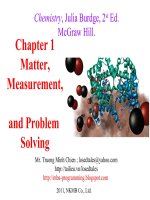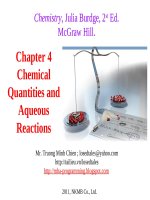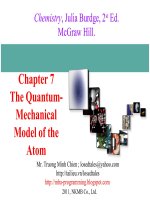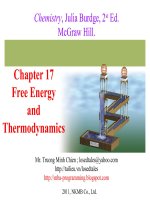Bài giảng Chapter 17 Free Energy and Thermodynamics
Bạn đang xem bản rút gọn của tài liệu. Xem và tải ngay bản đầy đủ của tài liệu tại đây (2.98 MB, 53 trang )
Chapter 17
Free Energy
and
Thermodynamics
2011, NKMB Co., Ltd.
Chemistry, Julia Burdge, 2
st
Ed.
McGraw Hill.
Mr. Truong Minh Chien ;
/>
Don’t get ahead of the game
•
There is a lot of theory in this chapter
•
Keep terms separate (5), and 4 equations.
Universe, System, Surrounds, Enthalpy, and Entropy
are all different, and you must know each
•
Memorize the 3 Laws of Thermodynamics
•
You can break a California State Law but you
can NOT break a Thermodynamic Law
2
Chemistry, Julia Burdge, 2
nd
e., McGraw Hill.
3
First Law of Thermodynamics
•
you can’t win!
•
First Law of Thermodynamics: Energy
cannot be Created or Destroyed
the total energy of the universe cannot change
though you can transfer it from one place to another
•
∆E
universe
= 0 = ∆E
system
+ ∆Ε
surroundings
•
Think of a match burning, crumbling paper, etc
Chemistry, Julia Burdge, 2
nd
e., McGraw Hill.
4
First Law of Thermodynamics
•
Conservation of Energy
•
For an exothermic reaction, “lost” heat from the system
goes into the surroundings
•
two ways energy “lost” from a system,
converted to heat, q
used to do work, w
•
Energy conservation requires that the energy change in
the system equal the heat released + work done
∆E = q + w
∆E = ∆H + P∆V
•
∆E is a state function
internal energy change independent of how done
Chemistry, Julia Burdge, 2
nd
e., McGraw Hill.
Tro, Chemistry: A Molecular Approach 5
Energy Tax
•
you can’t break even!
•
to recharge a battery with 100 kJ of
useful energy will require more than
100 kJ
•
every energy transition results in a
“loss” of energy
conversion of energy to heat which is
“lost” by heating up the surroundings
∆E = q + w
∆E = ∆H + P∆V
Tro, Chemistry: A Molecular Approach 6
Heat Tax
fewer steps
generally results
in a lower total
heat tax
Tro, Chemistry: A Molecular Approach 7
Thermodynamics and Spontaneity
•
thermodynamics predicts whether a process will
proceed under the given conditions
spontaneous process
nonspontaneous processes require energy input to go
•
spontaneity is determined by comparing the free
energy of the system before the reaction with the free
energy of the system after reaction.
if the system after reaction has less free energy than
before the reaction, the reaction is
thermodynamically favorable.
•
spontaneity ≠ fast or slow
Tro, Chemistry: A Molecular Approach 8
Comparing Potential Energy
The direction of
spontaneity can
be determined by
comparing the
potential energy
of the system at
the start and the
end.
Tro, Chemistry: A Molecular Approach 9
Reversibility of Process
•
any spontaneous process is irreversible
it will proceed in only one direction
•
a reversible process will proceed back and forth between
the two end conditions
equilibrium
results in no change in free energy
•
if a process is spontaneous in one direction, it must be
nonspontaneous in the opposite direction
Tro, Chemistry: A Molecular Approach 10
Thermodynamics vs. Kinetics
Tro, Chemistry: A Molecular Approach 11
Diamond → Graphite
Graphite is more stable than diamond, so the conversion of
diamond into graphite is spontaneous – but don’t worry, it’s
so slow that your ring won’t turn into pencil lead in your
lifetime (or through many of your generations).
Tro, Chemistry: A Molecular Approach 12
Factors Affecting Whether a
Reaction Is Spontaneous
•
The two factors that determine the thermodynamic
favorability are the enthalpy and the entropy.
•
The enthalpy is a comparison of the bond energy
of the reactants to the products.
bond energy = amount needed to break a bond.
∆H
•
The entropy factors relates to the
randomness/orderliness of a system
∆S
•
The enthalpy factor is generally more important
than the entropy factor
Tro, Chemistry: A Molecular Approach 13
Enthalpy
•
related to the internal energy
•
∆H generally kJ/mol
•
stronger bonds = more stable molecules
•
if products more stable than reactants, energy released
exothermic
∆H = negative
•
if reactants more stable than products, energy absorbed
endothermic
∆H = positive
•
The enthalpy is favorable for exothermic reactions and
unfavorable for endothermic reactions.
•
Hess’ Law ∆H°
rxn
= Σ(∆H°
prod
) - Σ(∆H°
react
)
Substance
∆
H°
kJ/mol
Substance
∆
H°
kJ/mol
Al(s) 0 Al
2
O
3
-1669.8
Br
2
(l) 0 Br
2
(g) +30.71
C(diamond) +1.88 C(graphite) 0
CO(g) -110.5 CO
2
(g) -393.5
Ca(s) 0 CaO(s) -635.5
Cu(s) 0 CuO(s) -156.1
Fe(s) 0 Fe
2
O
3
(s) -822.16
H
2
(g) 0 H
2
O
2
(l) -187.8
H
2
O(g) -241.82 H
2
O(l) -285.83
HF(g) -268.61 HCl(g) -92.30
HBr(g) -36.23 HI(g) +25.94
I
2
(s) 0 I
2
(g) +62.25
N
2
(g) 0 NH
3
(g) -46.19
NO(g) +90.37 NO
2
(g) +33.84
Na(s) 0 O
2
(g) 0
S(s) 0 SO
2
(g) -296.9
Tro, Chemistry: A Molecular Approach 15
Entropy
•
entropy is a thermodynamic function that increases as the
number of energetically equivalent ways of arranging the
components increases, S
•
S generally J/mol
•
S = k ln W
k = Boltzmann Constant = 1.38 x 10
-23
J/K
W is the number of energetically equivalent ways, unitless
Tro, Chemistry: A Molecular Approach 16
W (microstates possible)
Energetically
Equivalent States for
the Expansion of a
Gas
Tro, Chemistry: A Molecular Approach 17
Macrostates → Microstates
This macrostate can be achieved through
several different arrangements of the particles
These microstates
all have the same
macrostate
So there are 6
different particle
arrangements that
result in the same
macrostate









